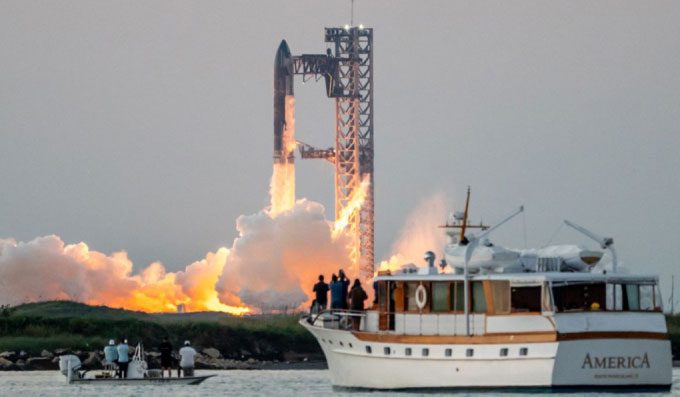The United States and China are leading missions to return humans to the Moon while also collaborating with other nations in their vision for space exploration.
Moon missions have become synonymous with the “space race”. During the Cold War, the competition between the U.S. and the Soviet Union for the “small step for man” on the Moon was a symbolic and strategic endeavor for dominance in politics, technology, military power, and ideology on Earth.
Geopolitical tensions are once again shifting beyond Earth. The U.S. and China are spearheading separate missions aimed at returning humans to the Moon. One goal is to advance scientific research. However, the exploitation of space and economic expansionism are also driving these efforts.
This new “race” could lead to new conflicts, especially regarding key landing sites and valuable, scarce resources believed to be located at the Moon’s south pole.

SpaceX Starship launching from Starbase near Boca Chica, Texas, on October 13 for the Starship Flight 5 test. (Photo: AFP).
Mining water ice could produce oxygen, drinking water, and rocket fuel—all essential for sustaining Moon exploration and beyond. The Moon may also contain rare earth metals used in everyday electronics and a rare non-radioactive isotope, helium-3, for nuclear energy.
Space exploitation could lead to a “Moon gold rush” or concerning trade wars involving nations and private entities in space. The off-Earth resources being mined are predicted to be worth trillions of dollars.
The U.S. has a longer history of capability, investment, and partnerships in the space sector. However, China is catching up. While the U.S. is conducting its first uncrewed landing at the Moon’s south pole this year, China has already executed several landings. In June, China’s Chang’e 6 mission returned with the first rock and soil samples from this coveted area of the Moon.
Both superpowers have invited other nations to join them in realizing their lunar visions. This week, the Dominican Republic became the 44th nation to sign the Artemis Accords, led by NASA.
Thirteen other countries are participating in the International Lunar Research Station (ILRS) led by China in collaboration with Russia. Senegal joined last month.
Space has fostered cooperation even among superpower rivals during times of geopolitical tension. During the Cold War, the U.S. and the Soviet Union cooperated on governance, law, science, and space technology. This built mutual trust and eased tensions.
More recently, NASA’s International Space Station (ISS) has been a testament to coexistence in orbit. Astronauts from the U.S., Russia, and other partners have conducted over 3,000 experiments in microgravity.
At the recent United Nations Future Summit, messages from astronauts on the ISS and China’s Tiangong space station reaffirmed the importance of international cooperation and the peaceful use of space.
Humanity stands to lose a great deal if global superpowers do not cooperate on space governance. There is a real and growing risk of exporting and exacerbating our Earthly conflicts into space. This will undoubtedly heighten tensions on the planet.
The U.S. and China need to seek opportunities for dialogue between the Artemis Accords and the ILRS. There are several similarities in their activities, governance principles, and planned guidelines.
To achieve this, the U.S. will need to reconsider the 2011 Wolf Amendment, a law that restricts NASA from using its budget to collaborate with China without Congressional approval. However, China lacks a comparable law and has recently expressed a willingness to cooperate, including sharing their rock and soil samples.
Sharing scientific information could help find initial common ground before further discussions on space governance. This could even lead to the unification of landing sites or lunar time zones. If a rescue mission is needed on the Moon, having compatible technologies through interoperability would make this much easier.
The U.S. and China are actively participating in the Committee on the Peaceful Uses of Outer Space (COPUOS), including the working group on space resources. However, treaty-making typically progresses slowly. This means more opportunities for communication, consistency, and clarity regarding space governance are needed. This could even support multilateral efforts.
The world needs to view space not just as a “race.” It is also an opportunity to improve international relations, benefiting humanity’s future on Earth and, one day, beyond.




















































